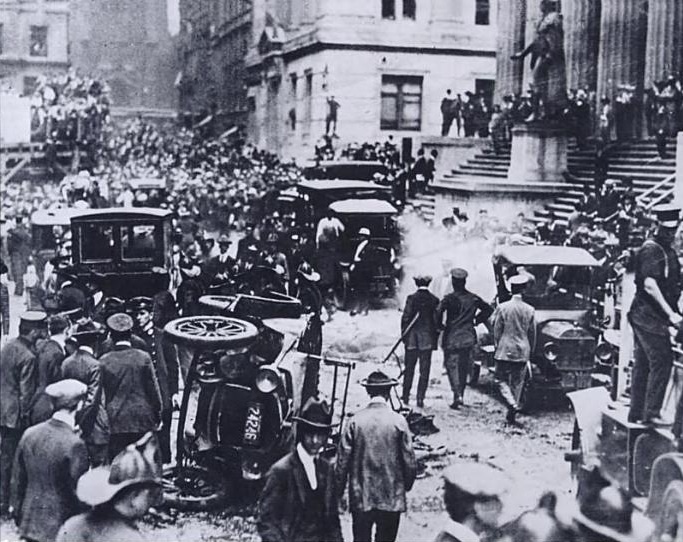This Day in Labor History: September 16, 1920

On September 16, 1920, a bomb went off on Wall Street at 12:01 PM. It killed thirty people and seriously injured 143. Almost certainly the work of extremist Italian anarchists under the influence of Luigi Galleani, it remains the most deadly example of left wing violence in American history.
Luigi Galleani was an influential Italian anarchist who had built upon the ideas of Johann Most, the anarchist whose ideas spurred the bomb at the Haymarket in 1886, to promote the “propaganda of the deed.” In short, the idea here is that any act of violence is acceptable, even if innocent people die, because the oppressive state response will lead others toward revolution. Like a relatively sizable number of European immigrants to the U.S., he came to this country to escape political persecution for his ideas, in this case a prison sentence back home for his activism. He worked in the textile mills of Paterson, New Jersey for awhile and then lived in Vermont and Massachusetts, all the while promoting his ideas of anarchist direct violence. He would be deported during the World War I Red Scare. Back at home, he continued to promote violence while also opposing the hierarchical Communist Party developing in the Soviet Union. In short, he was a true anarchist, both in terms of opposing all kinds of official organization and in being indifferent as to how he impacted others. Not surprisingly, Mussolini had him arrested and he spent most of his later life in prison, though he was semi-free when he died in 1931.
Beginning in 1914, Galleani’s Italian-American followers began taking his ideas and putting them into action. As often happens, many of the attempts to use violence were pathetic. They tried to deliver a bomb to John D. Rockefeller Jr.’s Tarrytown mansion after the Ludlow Massacre. He wasn’t home, they were denied entrance, then the bomb went off back in the safe house and killed three of them. Then in 1919, after Galleani spoke at a strike in Taunton, Massachusetts, four of his followers decided to bomb the factory. The bomb went off early and killed all four of them. So yeah, anarchists……..Don’t look for competency, do look for ideological action. In June 1919, his followers set off eight bombs almost simultaneously around the nation. The only people who died was the guy trying to bomb Attorney General A. Mitchell Palmer’s house and a night watchman inspecting a package targeting a right-wing judge.
But for once, in September 1920, the Galleanists actually did something right, or at least they succeeded in their target. At lunch time, a bomb in a wagon exploded, with 500 pounds of weights inside. The shrapnel blew everywhere. In fact, some damage can still be seen today on some of Wall Street’s older buildings if you know where to look. The horse died, the driver escaped. While the bomb did destroy much of the J.P. Morgan building, it’s not like it killed any leading capitalists. The people who died were stenographers and other low-level workers, people just trying to make a living. But hey, the revolution or something.
To this day, we don’t really know who was the responsible person. The most likely candidate is the well-known Italian anarchist Mario Buda, or at least anarchist-sympathetic historians have suggested this. Possibly this was closely related to previous issues of repression, more likely it was a response to the arrest of Nicola Sacco and Bartolomeo Vanzetti for murder in Massachusetts, a charge that at least Vanzetti was clearly innocent of, though Sacco maybe not. Buda is also believed to have constructed a lot of the big anarchist bombs of the time, though again, most of them ended up in disaster for the anarchists involved. Buda left the U.S. almost immediately after this, later was an informer for Mussolini in order to keep himself free (his info helped foil an anarchist plot to kill Il Duce), and then went back to promoting anarchist violence after World War II, until his death in 1963.
To say the least, this manifestation of the Propaganda of the Deed did not create revolutionary conditions in the American or global working classes. Most of American labor was disgusted by all of this. With American radicalism pretty quickly coming into line with the Communist Party, there was no large outpouring of support for the anarchists. The FBI was pretty flummoxed by all of this and never did arrest anyone for it. The Harding administration tried to blame the Soviets, but this was ridiculous and without any evidence. The only community in which any of this still held sway was among Italian-American radicals. They would continue with this kind of terrorist bombing for years, culminating in another failed assassination attempt, this time of the judge in the Sacco & Vanzetti case in 1932. This did have one impact though, which was to scare the judge, Webster Thayer, so much that he lived the rest of his life in great fear of assassination, so I guess at least the bastard had to deal with some sort of consequence for railroading those two Italian anarchists to the chair.
This is the 493rd post in this series. Previous posts are archived here.


